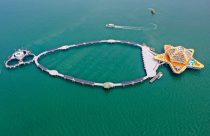The Need for Developing Marine Farms Inspired by China’s Successful Experiences
Sea News – Analytical Report
Our country, Iran, with over 5,800 kilometers of coastline in the north and south, holds one of the world’s top potentials in fisheries and aquaculture. However, declining fish stocks, environmental and economic challenges, and pressures from overfishing have highlighted the urgent need for transformation in marine resource management.
China: A Global Model in Marine Farm Development
China, the world’s largest producer of aquatic products, has emerged as a successful model in this sector through targeted investments and the use of advanced technologies. Examining China’s experiences can serve as an effective guide for developing this industry in Iran.
China’s Successful Projects:
- Shenzhen Marine Farm: Covering over 50,000 hectares, this project uses artificial intelligence and environmental sensors to produce 10 million tons of fish and shrimp annually.
- Artificial Habitats in the Yellow Sea: In this region, China has created underwater structures to establish new habitats for endangered species, boosting productivity by 30%.
- Floating Marine Farms in Hainan: Equipped with automated systems for aquaculture management, these farms have reduced species mortality rates by 15%.
Analyses indicate that China’s success results from a combination of long-term investments, technological innovation, and supportive policies.
The Current Status of Fisheries and Aquaculture in Iran
Iran, with an annual production of 1.3 million tons of aquatic products, holds a significant share of regional production. However, studies show the country’s potential exceeds 2 million tons per year.
Key Challenges:
- Declining Fish Stocks: Commercial fish stocks in the Persian Gulf have decreased by more than 40% over the past two decades.
- Illegal Fishing: Approximately 200,000 tons of illegal fishing are recorded annually, exacerbating ecosystem destruction.
- Lack of Modern Infrastructure: Only 20% of the country’s fisheries projects are equipped with state-of-the-art technology.
- Environmental Pollution: Industrial and oil pollutants entering the Persian Gulf and the Sea of Oman put natural habitats under pressure.
Analysts believe that a lack of coordination among executive bodies and the absence of supportive policies for producers are key reasons for stagnation in this sector.
Opportunities for Marine Farm Development in Iran
Given Iran’s unique geographical advantages and existing potential along its coasts, there are significant opportunities to develop marine farms. In this regard, the Makran coast, with access to deep and suitable waters, stands out as one of the best areas for establishing marine farms. Additionally, the Caspian Sea offers high potential for cultivating species such as sturgeon and cold-water fish.
This development could significantly contribute to economic growth and job creation in the country. It is estimated that the establishment of marine farms could create over 50,000 direct and indirect jobs. Furthermore, increasing exports of marine products to Gulf Cooperation Council countries and Southeast Asia could bring over $500 million in annual revenue.
Adopting China’s Model: Steps for Iran
By leveraging China’s successful experiences, Iran can accelerate its fisheries and aquaculture development. One effective step is investing in research and development for indigenous technologies, including the creation of artificial habitats, using environmental sensors to monitor water conditions, and developing automated aquaculture systems. Additionally, launching pilot projects along the southern coasts in collaboration with knowledge-based companies and focusing on cultivating specific species such as shrimp, fish, and sturgeon can pave the way for progress in this sector.
Anticipated Benefits for Iran:
- Increased production
- Environmental conservation
- Strengthened local economies
- Enhanced exports
Analyses show that developing marine farms is not only an economic opportunity but also a necessity for preserving the country’s marine resources. China’s successful experiences can serve as an effective model for Iran. To fully harness these potentials, the government’s pivotal role in creating supportive policies, providing infrastructure, and facilitating legal processes is crucial. By adopting supportive policies, utilizing modern technologies, and fostering international collaborations, Iran can become a prominent player in the regional fisheries and aquaculture sector. This approach, while protecting the environment, will strengthen local economies, promote a marine-based economy, and increase national production, charting a bright future for the country.

